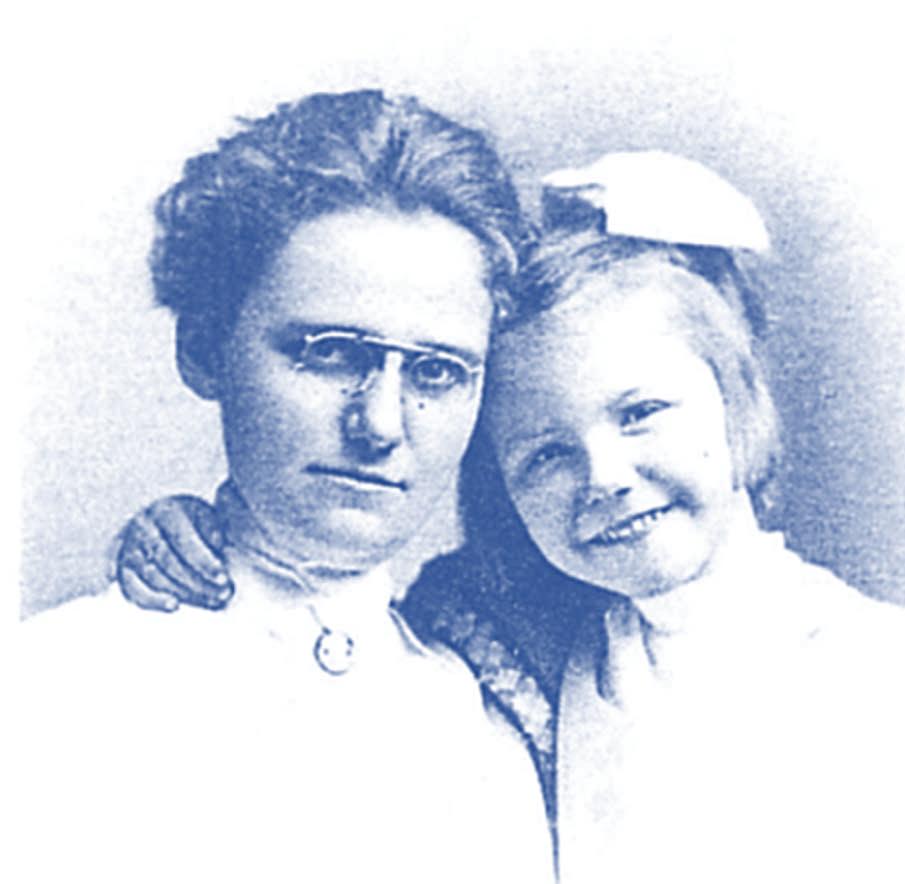
Nellie Becker: A Titanic Story Residents’ Generosity Second Century Update Annual Meeting Success In this issue:
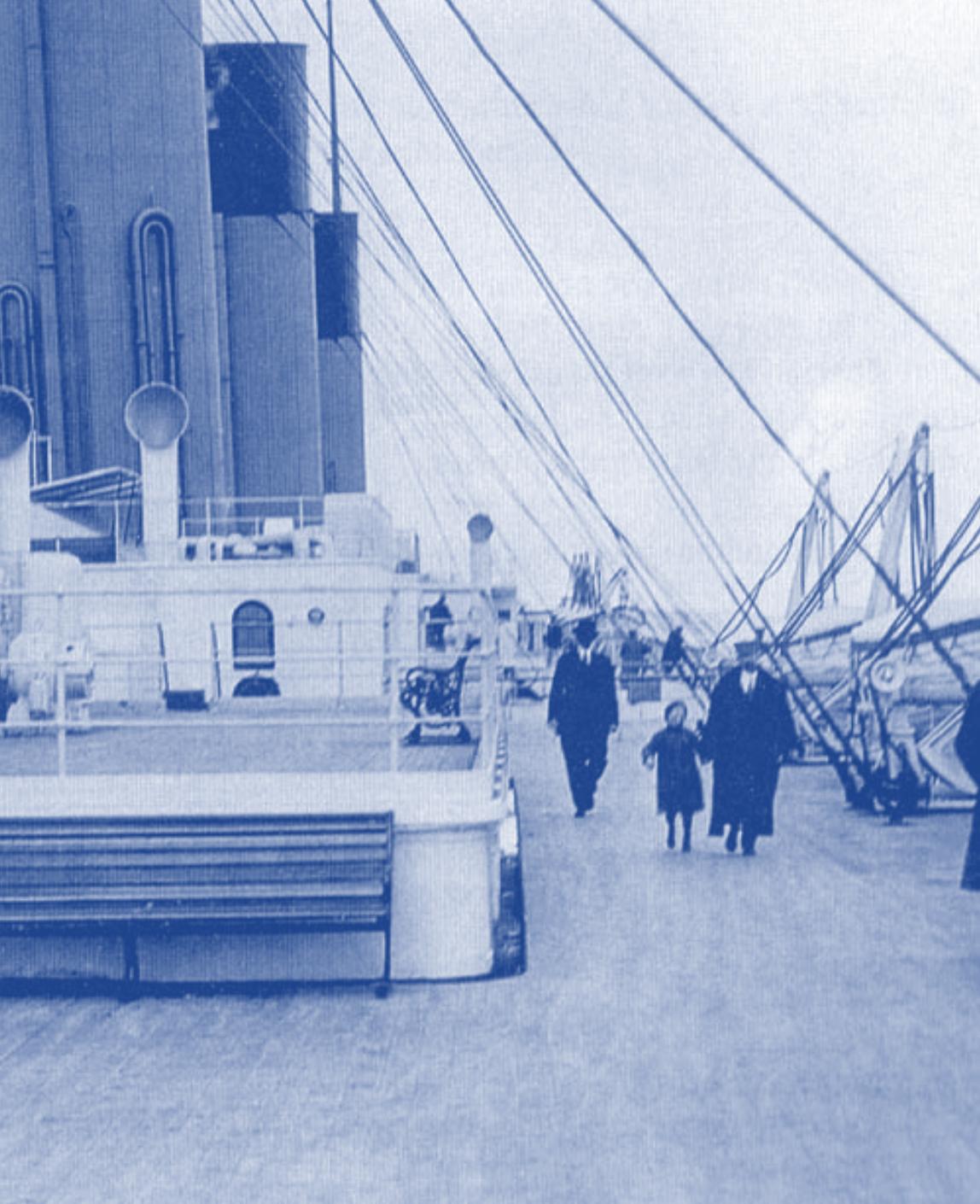
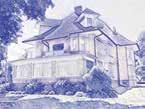



Nellie Becker: A Titanic Story Residents’ Generosity Second Century Update Annual Meeting Success In this issue:



2023 ended with a bang – in more ways than one
His presentation was sobering yet informative. Thanks so much, Jack!
For the Bureau County History Center, the year 2023 ended not with a whimper but with a bang – and I’m not talking about when the out-of-state semi truck driver crashed her rig into and through the 160-year-old Red Covered Bridge. (Well, maybe I am – we’ll get to that a bit later.)
On Nov. 4, the History Center collaborated with the Cherry Mine Disaster Museum to host an Authors Forum about that key tragic event in county history. We planned for 50 attendees and hoped for 100. When 175 people showed up to hear four authors speak, we couldn’t have been happier!
That was followed by a successful annual meeting and dinner held at The Barn at Hornbaker Gardens on Nov. 16. We were pleased that 140 people turned out to learn about our activities from the past year. They also eagerly listened as Jack Rooney, a Cherry native who lives in the Springfield area and who is also a new member of the Bureau County Historical Society Board, gave a fascinating talk about what life was like in Cherry at the time of the 1909 mine disaster.
 By Jessica Gray Curator, Bureau
By Jessica Gray Curator, Bureau
So by that point, our programs, exhibits and special events had attracted a combined total of 1,500 people – a nice increase from the previous year!
All right, now we’ll get back to the Red Covered Bridge. Nov. 16 was the second time in 2 ½ years that the bridge has been struck by an out-of-state semi driver who was just following GPS directions. My goodness! The damage was extreme, forcing the bridge to close and causing great worry among its many fans.
Fortunately, by December the Illinois Department of Transportation was on the job, shoring up the bridge’s wobbly roof and stabilizing the structure so that it could survive the winter and, we hope, be ready for permanent repairs in the spring.
Bureau County History Center staffers were also on the job, collecting photos and reminiscences about the bridge, contacting local and area leaders, attending meetings, and advocating for a timely and complete restoration. Lex Poppens advocated for the bridge in front of the TV news cameras on several occasions. Well done, Lex!
That iconic bridge is so very important to our county’s identity. The accident certainly drove that message home.
An iconic building that is so very important to our History Center’s identity is the Clark Norris Museum. It was built in 1900 as a residence. It opened as our
 By Lex Poppens
By Lex Poppens
A very exciting year ahead!
Welcome to 2024! As we explore the rich history of Bureau County, we continue to find amazing people who have either changed the course of history or been a part of significant moments.
As a donor or member, we hope you enjoyed your recent copy of A Bridge commemorative book we published. We are able to publish books like this and advocate for this iconic landmark because of your support. If you would like to purchase additional copies, there is an order form in this issue.

In this edition of The Chronicle we bring you one family’s tragic story of their experience on the Titanic. When I undertook researching this story, I felt strongly I wanted to tell it in a particular way. There are reams of information available pertaining to the Titanic, but the story of this particular family: Nellie Becker and her children, Ruth, Richard, and Marion, remained largely unknown.
We have a very exciting year ahead, beginning in March with the 1912 exhibit. This year-long exhibit will explore life in Bureau County in 1912. As part of the upcoming exhibit, Curator Jessica Gray follows the life and challenges of Nellie Becker, who, with her three children, survived the disaster.
Volunteerism has been a centerpiece of our organization. When we met with the Princeton Veterans Organization regarding our recent Veterans Exhibit, we had no idea of the depth of their love for our
We’ve had one piece of Nellie’s story in our archives for many years, as Nellie and her husband would later live in Princeton, but we did not know the full version of events. I learned Nellie wasn’t kind to her children in her later years and was known to have emotional outbursts. I wanted to know why. Nellie had 84 years of life, 58 years of marriage, and four children. There’s a lot of living in those numbers. I wanted to know what happened at the beginning to make her who she was at the end – a deeply unhappy woman.

community and their commitment to our collective history. Be sure to read the Second Century update and learn how they are continuing to help us.
We’d also like to thank Wyanet Carpet for helping with part of our cosmetic renovation of the Sash-Stalter-Matson Building.
Our first annual meeting since the pandemic was in November 2023. We launched a new award, History Heroes, which recognizes people who have furthered our mission. We were delighted to award this to five people and one business. If you would like to nominate someone as a History Hero, give us a call.
Finally, we want to thank all our donors and members who supported us during 2023. Your generosity allows us to continue exploring our collective history and presenting it in a contemporary and meaningful way.
Explore your History!
Sincerely,
 Lex Poppens Executive Director
Lex Poppens Executive Director
This is a story about mental health challenges and how those who’ve suffered with them – particularly women – have historically been treated. This is a story about trauma, grief, and how both can affect the brain’s processing of events. There are portions in the family’s written accounts which differ from one another. Nellie wrote in an article three months after the sinking they grabbed blankets before they fled their stateroom for the lifeboats.

CURATOR’S NOTES, from page 3
Nellie excluded entirely the moment where she asked Ruth to go back down four flights of stairs to their room for blankets, narrowly resulting in Ruth, or the entire family, to miss the lifeboat. Ruth, meanwhile, recited this incident in minute detail, and her family later pointed to this moment as the keystone upon which Nellie’s mental health struggles would rest. According to Ruth, Nellie learned on the Carpathia from their bedroom steward the Titanic was breaking apart right beneath their stateroom, hence the haste with which he urged them to the deck. Nellie felt certain her daughter nearly drowned because of her decision to send her back.
Nellie also recalled being brought aboard the Carpathia into the dining saloon where she found the doctor treating her two younger children, and that Ruth was there as well. In actuality, when her mother was rescued, Ruth was walking the ship with a woman from lifeboat 13 aiding her in a search for her infant placed in lifeboat 11. Nellie would solicit the aid of another female passenger in a frantic search of the Carpathia for her daughter for over two hours. By the time Nellie wrote her account, the gravity of the trauma she endured resulted in the omission of all the moments her daughter was separated from her and her fate was uncertain.
This is the harrowing story of a mother who was forced to make impossible decisions very quickly, decisions upon which the lives of her three children would depend. For the rest of her life she would relive those moments, placing her at a greater distance from her own family, who were only aware of her chaotic and unstable behavior, and not the fear which still held her in its grip. I hope you read the story and find empathy in your heart for Nellie and Ruth. May we find empathy for all the untold stories that burden the hearts of those we love.
Jessica Gray
Life is filled with individual decisions, some simple, some crucial, that lead you down one path or another. Had you chosen otherwise, had you gone another way, had you paused a moment longer, things may have ended differently. This is the story of just such a life.
Nellie Estella Baumgardner was 22 years old, a pretty and accomplished young woman, an 1896 graduate of Wittenberg College in Ohio, when she accepted an offer of marriage from her classmate, Allen O. Becker of Berrien Center, Michigan.
Just two months after their wedding in 1898, Becker, who had gone on to become a pastor, was instructed by the Board of




Gifts back then made it what it was; gifts now can help to revive itBy Jim Dunn President, Bureau County History Center Board
Bringing the former Matson Public Library building, which first opened in 1913, back to life is an ongoing challenge for the Bureau County History Center Board and staff members.
We’ve made an initial start, but we still have a long, long way to go.
What has impressed me is the willingness of people to contribute to this effort. A great example is the generosity of Gary Johnson, who paid for the creation and placement of a Civil War Monument that honors Bureau County’s Black soldiers on the grounds of the former library.
That act helped to focus more efforts on this building, now known as the Sash-Stalter-Matson building. Prior to the monument’s dedication, the City of Princeton installed a new sidewalk out front, and the Historical Society paid for the concrete approach to the front steps.
More work has been done inside the building, which was last used as a library in 2007. Volunteer painters

Foreign Missions of the Lutheran Church to leave immediately to serve in India. They arrived in southern India in late December.
Unfortunately, the Beckers
arrived in the middle of a devastating famine and cholera epidemic. Sick individuals would arrive at the mission seeking medical attention only to die on their doorstep.
Having been raised gently in an upper-class family in Springfield, Ohio, Nellie had no training to handle what she witnessed. Every morning she would find more bodies outside her home. Nellie suffered a nervous breakdown, setting off what would become a lifetime’s worth of mental health struggles.
Despite her fragile state, Nellie became pregnant, giving birth to her daughter, Ruth, on October 28, 1899.





– Brad Oeder and Rodney Johnson – spent time in December painting the former children’s library room in the lower level. Let me tell you, that was a big job! Also, BCHC paid for electrical and lighting work to restore the functionality of those systems.
More volunteer work and more donations will surely be needed as the rehabilitation proceeds. Of course, a key donation made it all possible in the first place, when Robert Sash donated the Matson building to the Historical Society in December 2013.
Gifts by generous people, the archives of the Bureau County History Center tell us, are nothing new for the beloved Matson building.
In 1927, Pauline Schenk wrote “The Story of The Matson Public Library And Some of its Larger Gifts.” This booklet details generous donations by community members that enhanced the library, whose cornerstone was laid in 1912 and which opened to the public in April 1913.
Let’s take a look at some of those long-ago gifts.
Nehemiah Matson, who died in 1883, donated his estate to create a library, valued at $11,862.67. The gift by Matson, a noted historian and author, so inspired the
SASH-STALTER-MATSON, continued on pg 7

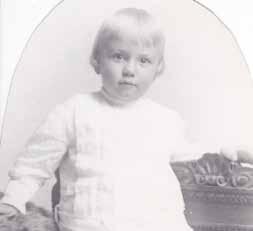

After five years of service in India, Nellie’s state of mind became so urgent, Rev. Becker brought her and Ruth back to the United States. Nellie gradually recovered, and Ruth met her grandparents. Once again, Nellie became pregnant, delivered a son, Luther, in March 1905. In December, the family returned to India for Rev. Becker to resume his work.
The family’s health struggles continued. Luther, not yet two years old, was diagnosed with tetanus and died on February 7, 1907. Once again, Nellie was not given the space and time to grieve, and immediately became pregnant again, delivering a daughter, Marion, on December 28, 1907. Nellie would give birth to her last child, Richard, on June 26, 1910. It was immediately apparent this child was not as robust as Ruth and Marion. Doctors told Nellie plainly that Richard was suffering from the climate in India and he would surely die if she did not take him back to the United States.
The Trek Home
Having lost a child already, Nellie was unwilling to risk the life of another. Although initially intending to travel with them, Rev. Becker became too ill to leave. Nellie was forced to make the journey from India to England, and then onward
to America, alone with her three children and everything they owned in tow.
After another harrowing 29-day journey by boat, Nellie and her children arrived in London. The morning of April 10, 1912, found Nellie and her children standing at the White Star Line terminal, in awe of the 883-foot-long Titanic rising above them.
In the years that followed, Ruth would recall her mother being anxious about the voyage. Despite Nellie’s worries, the family was amazed at the grandeur of the ship.
“We were charmed with this lovely, large boat,” Nellie wrote. “The library was a picture, and the dining room, with its carved oak frieze and tables of snowy linen and glittering silver, was a dream.”
For the rest of her life, Ruth would be able to recall the exact layout of their room. “Our cabin was on the port side and very close to the waterline. I could look through the porthole and see the ocean. The water would be almost up to my eyes,” she said.
Ruth would spend the next few days looking after her brother, Richard, pushing him around the deck in a stroller, while her mother cared for Marion.
Shortly after 11:40 p.m. on Sunday, April 14, Nellie awoke with a start. Something was wrong. Nellie initially encountered a steward in the hallway who told her all was well and instructed her to go back to bed.
“But other noises began, and people shouted to each other in the corridors, and I could stand it no longer. I met my cabin steward just outside my door with a life belt in his hand, and before I could say anything he said, ‘Tie on your life belt and come quickly.’ ‘But,’ I said, ‘I have three children; have I time to dress them?’ He was tying the lifebelt on me then, and said, ‘Madam, you have time for nothing; come at once.’”
Nellie ran back into the room and shook Ruth awake, instructing her to put shoes and stockings on Marion while she did the same for Richard. They quickly pulled on their coats over their own nightclothes and ran from the room.
When the family reached the foyer on B deck, they found a group of female passengers, also in their nightclothes.
While they waited for instructions, as Ruth recalls, Nellie suddenly
The Titanic sank in the frigid Atlantic Ocean on the night of April 14-15, 1912. The tragic loss of over 1,400 lives that night, the failures of the great unsinkable ocean liner, the insufficient lifeboats, all would affect legislation of ship building and sea travel in the months and years to come. Over 700 survivors would return home and try to pick up the pieces. Many would suffer from the reverberations of that night for the rest of their lives, with some experiencing alcoholism, depression, posttraumatic stress, even suicide.
With such an enormous tragedy playing a central role upon the world’s stage, what was happening here, in Bureau County? We’ll take a look at the photographs and stories that the lives of residents here revolved around. Newspaper stories will run the gamut from the ordinary: bids for the building of Matson Public Library were discussed and the architect’s proposal for the Soldiers and Sailors Monument were accepted ahead of its projected summer 1912 build; to the criminal: three masked highwaymen rob the train in Sheffield stealing $800 in cash and a diamond ring; to the scandalous: the front-page coverage of the divorce of the heroic doctor of the Cherry Mine disaster after his wife alleged she was the victim of domestic violence.
From the sad, to the humorous, to the political, we hope the exhibit gives you a better understanding of what life was like here in 1912. Join us March 2nd for this new exhibit and all the events we have planned for you!

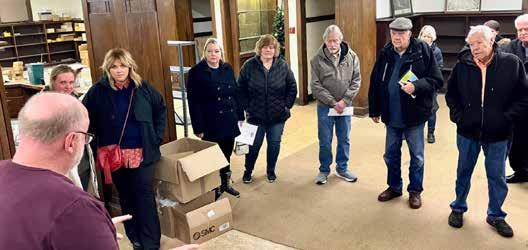
SASH-STALTER-MATSON, from pg 5 community that it was decided the library would bear his name.
Samuel P. Clark donated real estate and securities valued at $10,280.
Clark, of course, is the man who built the mansion that is now the Clark Norris Museum.
The Woman’s Club donated $3,400 on the condition that an assembly room be placed on the second floor where its members could meet.
Charles J. Richardson donated $2,000 for the purchase of books.
Douglas Moseley donated $1,000 and the cluster street lamps in front of the library.
Elizabeth Richardson Garland donated $1,000.
First National Bank donated real estate valued at $500.
Also donating $500 apiece were E.P. Lovejoy and his children, Mrs. Mary A. Jones, and Mrs. Sarah A. Delano. Hubert A. Clark donated $200.
The Princeton High School Board donated $162.22.
The Princeton Book Club donated 800 books.
Elijah Dee donated steel portraits of George Washington, Abraham Lincoln, Ulysses S. Grant and William T. Sherman. E.A. Vaughan donated frames for the portraits.
E.P. Lovejoy, Palmer Anderson and Frank W. Clark donated the card catalog case.


SASH-STALTER-MATSON, continued on pg 10

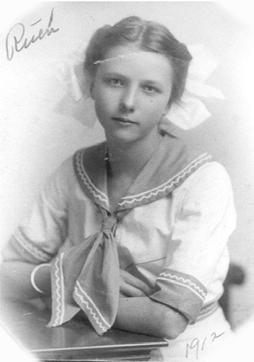
NELLIE, from page 6 realized how cold it was that evening. “Ruth,” she asked, “It is so cold outside, will you please go down into the cabin and get some blankets?”
Ruth agreed and ran back down four flights of stairs to their cabin. Decades later the family would point to this moment as one that most affected Nellie’s mental health. Without thinking, or without realizing the seriousness of the situation they were in, Nellie sent her daughter back into the belly of a sinking ship for blankets.
Lifeboat 11 was nearly full when the Becker family reached it, but they stopped its lowering to take in Marion and Richard. Nellie was likely unaware she would not be allowed to join them.
As soon as the children were seated, a voice rang out, “That’s all for this boat,” and it began dropping slowly toward the sea.
“Oh, please let me go with my children!” Nellie screamed.
According to Ruth’s account, a crewman quickly helped lift her mother over the rail and into the
lowering boat. As her mother turned around, she realized what she had done. She had forsaken her 12-year-old daughter!
Although Nellie would later claim she did not fear for her daughter’s life, even before she knew she made it to a lifeboat, Ruth recalled her mother screaming to her as the lifeboat was lowered.
“Ruth, get in another boat!”
“May I Get in this Boat?”
With the fearlessness of a child, Ruth walked just aft where lifeboat 13 was being loaded. She recalled asking the crewman in charge, “May I get in this boat?” Without a word, she said, the officer “picked me up and dumped me in.”
It had not yet occurred to Ruth how dire their situation was, but as her lifeboat was being lowered, she could see rows upon rows of anxious faces crowding the rail.
“There were five or six decks and they were just lined with people, standing there at the edge looking over. I suppose they were wishing and hoping someone would come and rescue them,” she said.
From Ruth’s vantage point, it appeared lifeboat 15 was the only one remaining to be lowered — and its capacity of 60 persons was not nearly adequate to save all those who remained.
As they drew away from the ship, Ruth saw rockets shoot upward, bursting in the dark sky overhead, and below, the great ocean liner was slowly sinking.
“The lights were just going under the water as it went down and I remember that very plainly,” she said.
Even from the distance of their lifeboat, Ruth could see passengers jumping from the ship into the water. Suddenly, a deafening noise cracked across the water in the darkness as the ship split in half,
breaking between the funnels, the bow sinking, while the stern rose up for one final moment, before it too sank beneath the Atlantic.
Ruth had entered her lifeboat with 60 strangers at around 1:40 a.m., and just 40 minutes later, the ship and all her remaining passengers were gone.
Though the ship had disappeared, the screams of the survivors in the freezing water would continue on for another 30 minutes, before all gradually became eerily, hauntingly silent.
Ruth’s lifeboat, like most of the others, did not return to pick up survivors for fear of being overturned. Ruth recalled that the victims “jumped and they screamed and they yelled for help, and of course nobody came to help. … That was a terrible, terrible time. I can still hear them.”
Somewhere else in the inky blackness, Nellie, too, could hear the screams from her lifeboat.
“The heart-rending screams which arose nearer [the Titanic] were awful beyond words. I think I shall hear it and see that dreadful sight until my dying day.”
The lifeboats were meant to have biscuits, fresh water, lights, and a compass, but had no provisions whatsoever.
“While the night was clear, it was dark, and we could not see one of the other boats,” Nellie recalled. “There was nothing to do but drift until morning, then all come together.”
Just before dawn, a light appeared on the horizon. It was the Cunard liner Carpathia steaming toward them.
“No one but those in those lifeboats out in the middle of the Atlantic that bitter, cold night, will ever

know our joy when we first caught sight of the Carpathia,” wrote Nellie, in her account.
Ruth and lifeboat 13 rocked from side-to-side as they pulled up beside the ship, and the passengers were hoisted into the air, one-byone, to the boat deck. Four hours later, the occupants of Nellie’s lifeboat were finally rescued.
Nellie recalled four sailors carried her into the dining saloon where she saw her two youngest children being tended to by the doctor. Both Ruth and her mother would state one of their most vivid memories was the sight of scores of women standing at the rail looking out to sea, searching in vain for their husbands, after the last survivors were brought onto the Carpathia.
“Oh, those four sad, miserable days, with nothing to do, nothing to think about, nothing to talk about, but this great sorrow. The question was not, ‘Have you lost anyone?’ but ‘How many have you lost?’” Nellie wrote.
“We heard how there were not
enough lifeboats, and nearly all the men and many women and children had gone down with the Titanic … Oh, the horror of it all,” she wrote.
The Carpathia would pause momentarily in the course of that day to hold funerals and sea burials for those victims who did not survive.
On April 18, the Carpathia arrived in New York. Although it was raining heavily when they docked, thousands of onlookers waited by the piers. Nellie was not equipped to handle the onslaught and placed her daughter in the path of those clamoring for the story of what had happened to the great ship.
Though Nellie would write her account of her experiences for the Lutheran Women’s Work newsletter and attributed the strength of her faith for having gotten her through the experience, at home it was a very different story. The family was never again allowed to speak of the event in her presence without Nellie breaking down.
Rev. Becker would finally rejoin the family in Michigan nine months later in January 1913. It must have been a shock to find his wife so altered. Ruth would later recount that for years afterward her father would say, “Your mother wasn’t like this before the Titanic.”
While Nellie refused to speak about what they had been through, Rev. Becker had no such reservations, and would travel to various churches to give sermons on his family’s experience.
Over the next several years, the family would move with each new church appointment Rev. Becker received. Ruth married her college classmate in 1924, and had her first child, a daughter, Jeanne, in 1925. She would go on to have two sons, Dick and Rodger, before her marriage eventually ended in divorce.
Ruth’s children grew up in a tense household just as she had, with a mother refusing to speak of the tragedy she had experienced.


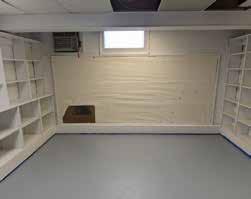


SASH-STALTER-MATSON, from pg 7
Dr. and Mrs. H.M. McKee donated an art glass window.
Mrs. D.H. Smith donated a fine Howard clock. Mrs. Dora Wilson Shugart and Mrs. Alfred Norris donated an oil portrait of Nehemiah Matson.
The Daughters of the American Revolution donated books, a flag and a bronze tablet commemorating a speech by Abraham Lincoln.
J.M. Stevens donated an oil painting of a landscape. And Mrs. I.D. Page and Capt. F.C. Duncan both contributed pictures.
What an impressive list of contributors and their contributions.
Those contributions helped to fund and furnish Matson Public Library, whose final construction cost totaled $23,000. Because of the monetary inflation that has occurred since 1913, rehabilitating the building, unfortunately, will be more expensive than the initial cost.
The BCHC Board is hopeful that the generous community spirit, which was quite evident when the Matson Public Library was built, will reassert itself as donations are solicited to bring the SashStalter-Matson building back to life as a museum and community gathering place.









If you’ve seen the lights on and activity at the SashStalter-Matson Building, you’d be correct. Unveiling the new monument to fallen Civil War Veterans began the “what if” process for this iconic building. For the monument dedication event, the exterior was given a much-needed paint job. That led to working with Elmore Electric to update the electrical system and lighting, including a dedicated light for our flag.
We began working with volunteers from the Princeton Veterans Group and Flags of Freedom. They have donated over 245 hours of their time, and it really shows! They have painted the former Children’s library (lower level) and given the entire room a good cleaning. We’ve also moved artifacts that were stored on the middle level to the storage room in the lower level. Soon we’ll have new flooring on the lower-level floor. The process of connecting all three buildings to the internet for future use has begun.
we will be able to announce limited use programs in the former library. We’d like your feedback. Send your thoughts to museum@bureauhistory.org.
We all believe that a former library is the perfect place to Explore your History!
Special thanks to representatives from the Princeton Veterans Organization and Flags of Freedom who have been volunteering tirelessly with the History Center and preparing the SashStalter-Matson Building for the public.

Last year, we began taking a serious look at our buildings and how they would best be used. Moving the Veterans Exhibit to an accessible space was a significant change to our operation. In addition to making sure it was accessible to all, it also marked the beginning of regularly rotating exhibits for the future. In March, we will be opening two simultaneous exhibits in the Clark Norris and Newell Bryant Museums.
All of this is so we can consider the former library for something other than temporary storage for exhibits. Our next goal is to create usable spaces. Very soon,
Meanwhile, in 1927 Rev. Becker and Nellie moved to Princeton so he could pastor St. Matthew’s English Lutheran Church, where again he recounted the family’s experience on the Titanic
The Beckers arrived in Princeton just 15 years after the disaster, and Nellie was not doing well. When Ruth’s children were young, they would travel to Princeton every summer to visit their grandparents, though the visits were always difficult. It was never clear what would upset their grandmother, but something would trigger her, sending her into an emotional fit.
Nellie was nearing 60 years old when Rev. Becker briefly had her institutionalized. Although it is unknown which institution Nellie was placed in or for how long she was a patient, common treatments at asylums in the 1930s included electric shock treatment, hydrotherapy – which involved locking the patient in a tub of ice water, medically inducing seizures or insulin shock, and lobotomies. Rev. Becker quickly brought her home to Princeton for fear of the medical treatments she may have been receiving.
Nellie’s mental state had been affected by her time in India, the loss of her son, and her terrifying experience on the Titanic. It was compounded by her fear for her children’s lives. Her emotions swung like a pendulum, mystifying her family, and she was unable to properly convey what she was experiencing. It would not be until 1980, after the return of Vietnam soldiers, that post-traumatic stress disorder would become a diagnosable condition.
Peace after Tragedy
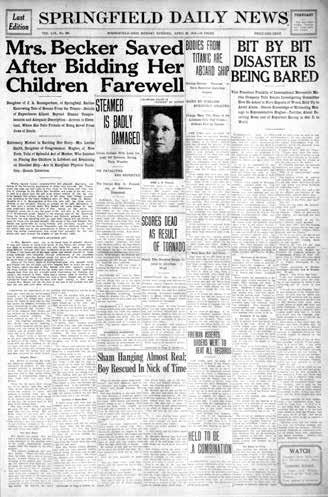
distance between her and her family. Nellie’s daughter, Marion, died of tuberculosis in 1944 in California. Although her remains were brought to Princeton and buried at Oakland Cemetery, Nellie refused to go to her funeral, having cut off communication years prior.
In 1956, Rev. Becker passed away in Eau Claire, Michigan, at the age of 84, always regretful he was unable to return to India and resume his missionary work. Although the couple moved to Michigan in 1945, Rev. Becker’s remains were placed in the family plot at Oakland.
Church, and she became the second Titanic survivor buried at Oakland.
Ruth only really began to unpack her experiences in 1982, when she was 83, and attended her first convention put on by the Titanic Historical Society. She would go on to attend conventions on the East Coast in 1987 and 1988 and would receive letters from all over the world from Titanic enthusiasts seeking her autograph.
The attention on Ruth and her story only increased when the wreckage of the Titanic was finally discovered 560 miles southeast of Newfoundland on September 1, 1985, by a U.S. – French led team using an underwater robot.
Although she agreed it was acceptable for artifacts to be brought to the surface, Ruth insisted they should be placed in museums, and not sold. As for the site, she was adamant it be treated with respect — it was the resting place for 1,495 lost souls.
After so much heartache and sorrow, in the end, Ruth chose to go back to where her story really first began. When she died July 6, 1990, at the age of 90, her remains were cremated, and her ashes scattered over the wreck of the Titanic
To read an extended version of this story, visit www.bureauhistory. org/nellie-becker-a-titanic-story/

The Bureau County History Center is a 501(c)3 nonprofit, public charity organization. Donations and memberships cover under 30% of our annual operations. The balance of our operation is funded through grants, restricted gift income, sponsorships, event ticket sales and advertising. As we prepare to reunite the Sash-Stalter-Matson Building with our community, our annual operating expenses will increase. A donation to the History Center’s future will only help.
Our goals are to present Bureau County history to our county both at one of the buildings on the History Center campus or by collaborating with other county historical societies and museums. It is our plan to partially open the Sash-Stalter-Matson Building later this year. To make that happen, your donation, of any size, will help.
In addition to building our endowment, here is our wish list:
• Bathroom Vanity
• Toilet (tall preferred)
• Paint
• Wall board
• Non-Slip Stair Treads
• Desk top computer
• $5,000 restricted gift for BCHC operations



For Nellie and her family, that would come too late, and her condition would place an increasing
For the next five years, Ruth would check in on her mother daily, enduring Nellie’s demands, her anger, and her manipulative tactic of constantly changing the terms of her will. Nellie died in 1961 of a heart attack at age 84. A funeral was held at St. Matthew’s
Sources: “Ruth Becker Blanchard” by Don Lynch, The Titanic Commutator, Vol. 14, No. 4, Winter 1990; Encyclopedia Titanica (2016) Marion Louise Becker; Encyclopedia Titanica (2016) Ruth Elizabeth Becker; Encyclopedia Titanica (2016) Nellie E. Becker; “Evocative Account of the Titanic Disaster by Mrs. Becker,” Lutheran Woman’s Work, pub. July 1912, reprinted in Voyage journal of the Titanic International Society #105 (2018).



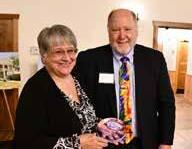
On November 16th, the Bureau County Historical Society and Bureau County History Center held the first annual meeting since the pandemic ended. It was a very enthusiastic crowd of 140 at the beautiful Barn at Hornbaker Gardens.
At the meeting, we announced the formation of the new public charity Bureau County History Center, which will be the organization that manages the properties and artifacts. It will also create and market events, exhibits and memberships. In addition, as a public charity, the donor benefits from this new 501(c)3 designation. The History Center moniker also speaks to the three-building campus. Board members from both organizations were announced for their two-year terms.
The meeting was held the same day that our beloved Red Covered Bridge was struck by a semi-truck. Executive Director Lex Poppens spoke passionately about the bridge and its importance to our community. He announced that the History Center will be advocating for restoration of the bridge. The membership responded with loud applause.
Center Board Chair Jim Dunn announced a new History Heroes award for community members who have


helped further the mission of the History Center and Historical Society. The awardees for 2023 are:
Gary Johnson
Kathy and Cliff Cartwright
Andy Austin-A&M Products
Michael H. and MaryAnn Johnson
Rick Marshall-GraniteWorks
Princeton Veterans Organization

The highlight of our evening was speaker and Historical Society Board Member Jack Rooney. His presentation was about life in Cherry, Illinois after the mining disaster in 1909. Cherry used to have a population of over 2,500. Jack spoke about the many wives and children of disaster victims and how their lives changed forever on that fateful day. Jack is a native of the village and cares deeply about its history.
The annual meeting was a wonderful dinner with friends. Our goal is to continue to share the history of our county and the impact it has had on our cities, state and country. Our growth in donations and memberships this year is truly indicative of the love we have for Bureau County!
Photos of the iconic Red Covered Bridge are now available in this new commemorative book. All photos and memories published were supplied voluntarily through social media or directly to us. Enjoy these photos and personal insights to the meaning of this historic bridge. Order your copy of A Bridge for the Ages today.



On Saturday, May 11 at 2:00 p.m., at Venue 450 in Princeton, the Bureau County History Center will be hosting historian Lt. Col. Peter D. Cook, the American Representative of the British Titanic Society, to give a presentation titled The Titanic, The Iceberg, and… The Rest of the Story.
Do you have questions about the Titanic? How many people (and animals) survived? Was there only one iceberg? Why weren’t the lifeboats fully loaded? Was the Titanic on fire when it set sail? Who was the last person to leave the Titanic? How is the Hershey Candy Company related to the Titanic?
Cook has an extensive collection of Titanic books, artifacts, survivor autographs, and even items raised
from Titanic. In addition to the British Titanic Society, Cook is also a member of the Titanic Historical Society, based in Massachusetts, and the Belfast Titanic Society. He has traveled to various Titanic locations including Belfast, Ireland to visit the Titanic Museum, the Harland & Wolff Shipbuilding Yard where the ship was built, and Southampton, England, where the ship set sail.
We hope you’ll join us as we welcome Peter Cook to learn more about the final days of this fascinating ship. There will be door prizes!
Venue 450 is located at 450 S. Main Street, Princeton. Tickets for this event can be purchased online at bureauhistory.org beginning March 1.








